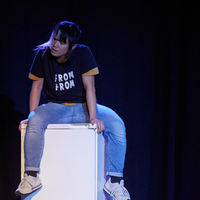Thu 1 Feb: Caroline Felkins, Paulina Krzeczkowska and Samantha Harding

News Story
Caroline Felkins Chaconne
Paulina KrzeczkowskaWoman in the Attic
Samantha Harding Resurrection
Frantic. Floor. Yoga. Anxious. These were the choreographic languages given to each of Samantha Harding’s four dancers. Initially portraying a sense of hopelessness within each of their briefs, their ascent to our promised Resurrection commences rather bizarrely by a football rolling across the stage. As the dancers finally work together to a compilation of scatty jazz and funk, they gain confidence in their movement as they return to their former selves. Unfortunately, this transformation is timid at best. In a piece about rebuilding oneself, the ending leaves much work left to be done.
Greeted by a menacing red light and the shadowy figure of a pacing woman, we were forced into Paulina Krzeczkowska’s lonesome, Jane Eyre-inspired world before we’d even sat down. “How does it taste to be so boundary-less?” She laughs, but the pain is tangible, simmering underneath the surface as a mirror reflects her demise from innocent child to panic-ridden wife hiding from her abusive husband and reduced to the pleasure of men. Krzeczkowska makes such an atmospheric, soul-baring, spoken-word piece seem easy and her words evidently resonated with her enraptured audience. Regrettably, after half an hour of subtle storytelling, I found her choice of an explanatory ending didn’t give Woman in the Attic the powerful finish it deserved.
Caroline Felkins's decision to subtly weave her onstage violinist (Raphael Papo playing Bach’s Chaconne) into her meditative, contemporary work was seamlessly done. Opening to the beat of her breath, Felkin is soon at the mercy of the violin as its music forces her to keep pushing forward, her flurry of limbs continuously gravitating back to Papo despite her uncooperative body (her hand refuses to leave the floor; fisted hands attack her neck). Surprisingly, despite exploring an emotion as complex as grief, the work settled into a repetitive rhythm that had lost my interest by the end.
Beatrice Thomas
Breath and the natural voice initiate the action in Paulina Krzeczkowska’s embodiment of a Polish woman, deprived of agency. Confined to her imaginary home, Krzeczkowska’s voice moves her body between sanity and madness. Gasps of pleasure push her into erotic poses; folk songs and poetic text send her skipping across the stage or held still in reflection. In a comical scene she mimics a stereotypical Polish wife, titillatingly making crumpets for her husband. A story of self-discovery unfolds with the help of minimal props – a free-standing mirror to reflect the woman she’s searching for and a red evening dress that transforms her into a desiring, self-obsessed diva. Krzeczkowska’s unrestrained, eclectic use of voice, fills her performance with pathos and adds her unique contribution to the histories of ‘mad women in the attic’.
Chaconne, Bach's impassioned partita for solo violin motivates Caroline Felkins's choreography with its themes of grief and mourning. She makes her own interpretation, creating an equally rich palette of gesture and floor work. Slumped in a sofa, Felkins observes virtuosic violinist Raphael Papo as he plays continuously. Soon the emotive roller-coaster of variations floods her body, flinging her onto the floor where she twists and flips in agonising, yet accomplished rolls or falls. Her angst-ridden physicality and introverted presence, even in the lighter musical variations, express an intensity that commands our attention. Chaconne is a fascinating investigation of the relationship between dancer and musician, foregrounding how both can co-exist as powerful separate entities despite articulating the si emotions.
Four women in a circle are struggling with stuttering movements and broken phrases that refuse to develop. Everything about the performers seems disconnected including how they interact with each other. Traffic sounds add to the increasingly incoherent landscape and it’s only towards the end of Samantha Harding’sResurrection that a change in music and a ball rolling across the stage seems to signal new beginnings. The women make contact. They help each other relax into distinct choreographic sequences enacted with more grounded intention. Resurrection definitely suggests some kind of self-realisation following self-doubt but ideas feel unresolved, leaving us with a sense of confusion and unfulfillment.
Josephine Leask


